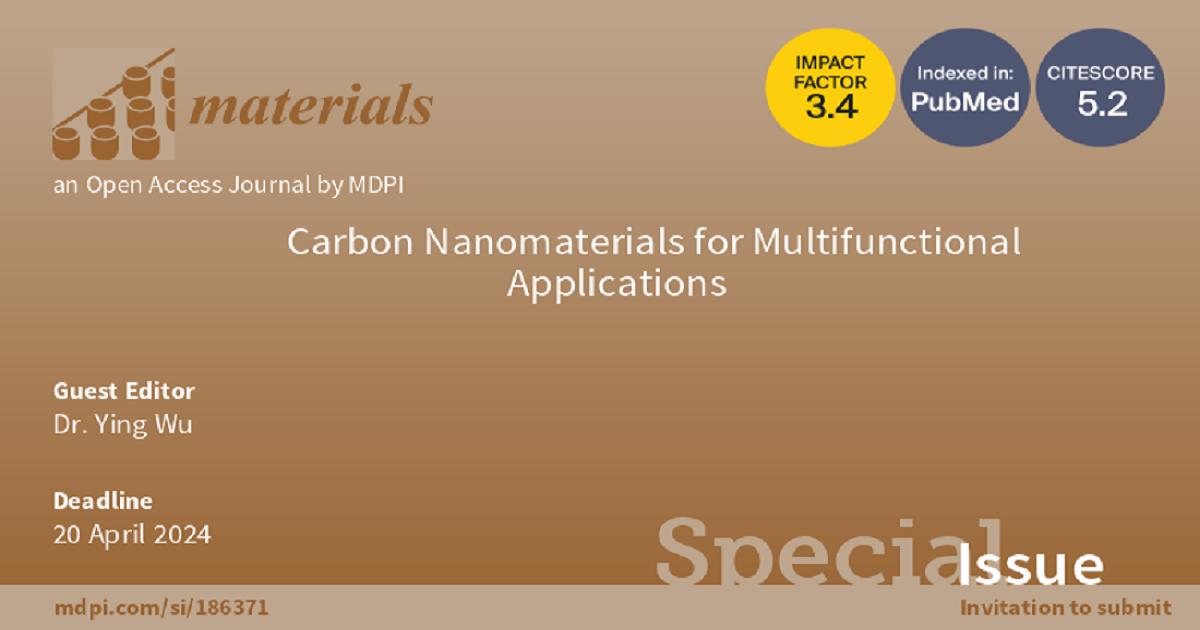Carbon Nanomaterials for Multifunctional Applications
A special issue of Materials (ISSN 1996-1944). This special issue belongs to the section "Carbon Materials".
Deadline for manuscript submissions: closed (20 April 2025) | Viewed by 10975

Special Issue Editor
Interests: multifunctional applications of graphene macroscopic assemblies; multifunctional applications of graphene/polymer composites
Special Issues, Collections and Topics in MDPI journals
Special Issue Information
Dear Colleagues,
Carbon nanomaterials have revolutionized the field of materials science, and their multifunctional applications continue to expand. From the discovery of graphene's remarkable properties to the development of novel carbon nanotubes and other carbon-based structures, these materials have opened up new possibilities for various industries. This Special Issue, titled "Carbon Nanomaterials for Multifunctional Applications", aims to explore the latest advances in harnessing the unique properties of carbon nanomaterials for diverse applications. Carbon nanomaterials, such as graphene, carbon nanotubes, and fullerenes, exhibit exceptional properties, including high mechanical strength, electrical conductivity, thermal stability, and a large surface area. These attributes make them invaluable for a wide range of applications, from electronics and energy storage to aerospace and biomedical devices.
We invite researchers to contribute their original research articles, communications, and reviews to this Special Issue. Topics of interest include, but are not limited to:
- Novel Fabrication Techniques: Exploring innovative methods for the synthesis and production of carbon nanomaterials, pushing the boundaries of what is possible in terms of structure, purity, and scalability.
- Design of Multifunctional Materials: Investigating the design and development of advanced materials that incorporate carbon nanomaterials to achieve multifunctionality. This may include flexible composites, coatings, and hybrids with tailored properties.
- Advanced Characterization: Presenting cutting-edge techniques and tools for characterizing the microstructure and properties of carbon nanomaterials, shedding light on their behavior in various environments.
- Applications in Emerging Fields: Highlighting the use of carbon nanomaterials in exciting and emerging fields, such as nanoelectronics, sensor technology, energy conversion and storage, catalysis, and more.
- Carbon Nanomaterials for Environmental Solutions: Exploring how carbon nanomaterials can address environmental challenges, such as gas adsorption and separation, water purification, and sustainable energy generation.
- Safety and Toxicology: Discussing the safety and potential toxicological concerns associated with the use of carbon nanomaterials, along with strategies for responsible research and application.
Dr. Ying Wu
Guest Editor
Manuscript Submission Information
Manuscripts should be submitted online at www.mdpi.com by registering and logging in to this website. Once you are registered, click here to go to the submission form. Manuscripts can be submitted until the deadline. All submissions that pass pre-check are peer-reviewed. Accepted papers will be published continuously in the journal (as soon as accepted) and will be listed together on the special issue website. Research articles, review articles as well as short communications are invited. For planned papers, a title and short abstract (about 250 words) can be sent to the Editorial Office for assessment.
Submitted manuscripts should not have been published previously, nor be under consideration for publication elsewhere (except conference proceedings papers). All manuscripts are thoroughly refereed through a single-blind peer-review process. A guide for authors and other relevant information for submission of manuscripts is available on the Instructions for Authors page. Materials is an international peer-reviewed open access semimonthly journal published by MDPI.
Please visit the Instructions for Authors page before submitting a manuscript. The Article Processing Charge (APC) for publication in this open access journal is 2600 CHF (Swiss Francs). Submitted papers should be well formatted and use good English. Authors may use MDPI's English editing service prior to publication or during author revisions.
Keywords
- carbon nanomaterials
- graphene
- carbon nanotubes
- fullerenes
- multifunctional materials
- nanoelectronics
Benefits of Publishing in a Special Issue
- Ease of navigation: Grouping papers by topic helps scholars navigate broad scope journals more efficiently.
- Greater discoverability: Special Issues support the reach and impact of scientific research. Articles in Special Issues are more discoverable and cited more frequently.
- Expansion of research network: Special Issues facilitate connections among authors, fostering scientific collaborations.
- External promotion: Articles in Special Issues are often promoted through the journal's social media, increasing their visibility.
- Reprint: MDPI Books provides the opportunity to republish successful Special Issues in book format, both online and in print.
Further information on MDPI's Special Issue policies can be found here.






